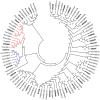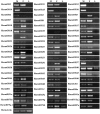Candidate olfaction genes identified within the Helicoverpa armigera Antennal Transcriptome
- PMID: 23110222
- PMCID: PMC3482190
- DOI: 10.1371/journal.pone.0048260
Candidate olfaction genes identified within the Helicoverpa armigera Antennal Transcriptome
Abstract
Antennal olfaction is extremely important for insect survival, mediating key behaviors such as host preference, mate choice, and oviposition site selection. Multiple antennal proteins are involved in olfactory signal transduction pathways. Of these, odorant receptors (ORs) and ionotropic receptors (IRs) confer specificity on olfactory sensory neuron responses. In this study, we identified the olfactory gene repertoire of the economically important agricultural pest moth, Helicoverpa armigera, by assembling the adult male and female antennal transcriptomes. Within the male and female antennal transcriptomes we identified a total of 47 OR candidate genes containing 6 pheromone receptor candidates. Additionally, 12 IR genes as well as 26 odorant-binding proteins and 12 chemosensory proteins were annotated. Our results allow a systematic functional analysis across much of conventional ORs repertoire and newly reported IRs mediating the key olfaction-mediated behaviors of H. armigera.
Conflict of interest statement
Figures






References
-
- Mustaparta H (1990) Chemical information processing in the olfactory system of insects. Physiol Rev 70: 199–245. - PubMed
-
- Bruyne M, Baker TC (2008) Odor Detection in Insects: Volatile Codes. Journal of Chemical Ecology 34: 882–897. - PubMed
-
- Rützler M, Zwiebel LJ (2005) Molecular biology of insect olfaction:recent progress and conceptual models. Journal of Comparative Physiology A 191: 777–790. - PubMed
-
- Sato K, Touhara K (2009) Insect olfaction: receptors, signal transduction, and behavior. Results Probl Cell Differ 47: 121–138. - PubMed
Publication types
MeSH terms
Substances
LinkOut - more resources
Full Text Sources

